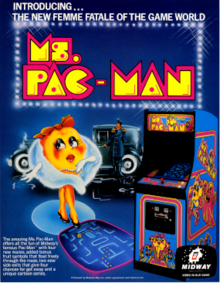
Back ምዝ ፓክ-ማን Amharic مس باك مان Arabic مس باك مان ARZ Ms. Pac-Man German Ms. Pac-Man Spanish Ms. Pac-Man Basque میس پک-من Persian Ms. Pac-Man Finnish Ms. Pac-Man French Ms. Pac-Man ID
| Ms. Pac-Man | |
|---|---|
 North American sales flyer | |
| Developer(s) | General Computer Corporation Midway |
| Publisher(s) | Midway |
| Designer(s) | Steve Golson |
| Composer(s) | Chris Rode |
| Series | Pac-Man |
| Platform(s) | Arcade, Atari 2600, Atari 5200, Atari 7800, Atari 8-bit, VIC-20, Commodore 64, ZX Spectrum, IBM PC, Apple II, TI-99/4A, Genesis, Master System, NES, Super NES, Game Boy, Game Boy Color, Game Gear, Lynx, Xbox One, PlayStation 4 |
| Release | [a] |
| Genre(s) | 1-2 players alternating turns |
| Mode(s) | |
| Arcade system | Namco Pac-Man |
Ms. Pac-Man[b] is a 1982 maze arcade video game developed by General Computer Corporation and published by Midway. It is a spin-off sequel to Pac-Man (1980) and the first entry in the series to not be made by Namco. Controlling the title character, Pac-Man's wife, the player is tasked with eating all of the pellets in an enclosed maze while avoiding four colored ghosts. Eating the larger "power pellets" lets the player eat the ghosts, who turn blue and flee.
General Computer made the game as a modification kit for the original Pac-Man, titled Crazy Otto. However, due to previous legal action with Atari, Inc., GCC was forced to present the project to Midway, the North American distributor of Pac-Man. Midway purchased the project and enlisted GCC to use the game as a basis for the sequel to Pac-Man. Multiple names were considered for the game, including Miss Pac-Man and Mrs. Pac-Man, before the final name was chosen for being easier to pronounce. While development had started without Namco's consent, company president Masaya Nakamura was brought in and provided feedback on the player character's design. The company ultimately collected the same royalties on each cabinet as they had with Pac-Man.
Ms. Pac-Man was acclaimed by critics for its improvements to the original gameplay and for having a female protagonist; some have described it as superior to Pac-Man. It has been listed among the greatest video games of all time and as one of the most successful American arcade games ever made.[2] The game's success inspired a variety of successful merchandise, several ports for numerous home consoles and handheld systems, a television cartoon that included Pac-Man, and numerous video game sequels and remakes that spawned a Ms. Pac-Man video game spin-off series. The rights to the game are owned by Namco's successor company, Bandai Namco Entertainment. However, the game and its title character have suffered various legal ownership issues between Namco and General Computer Corporation.[3]
- ^ "Play Meter Magazine, Volume 8, Number 4 - February 15th 1982". Internet Archive. 15 February 1982. Retrieved 23 December 2023.
- ^ Beamish, Graeme (May 22, 2010). "Pellet-popping power: Pac-Man turns 30 today". Nanaimo Daily News. Canwest News Service. Archived from the original on 14 October 2012. Retrieved 5 March 2012.
- ^ "Ms. Pac-Man is Being Replaced, and It's Likely Due to a Legal Dispute".
Cite error: There are <ref group=lower-alpha> tags or {{efn}} templates on this page, but the references will not show without a {{reflist|group=lower-alpha}} template or {{notelist}} template (see the help page).